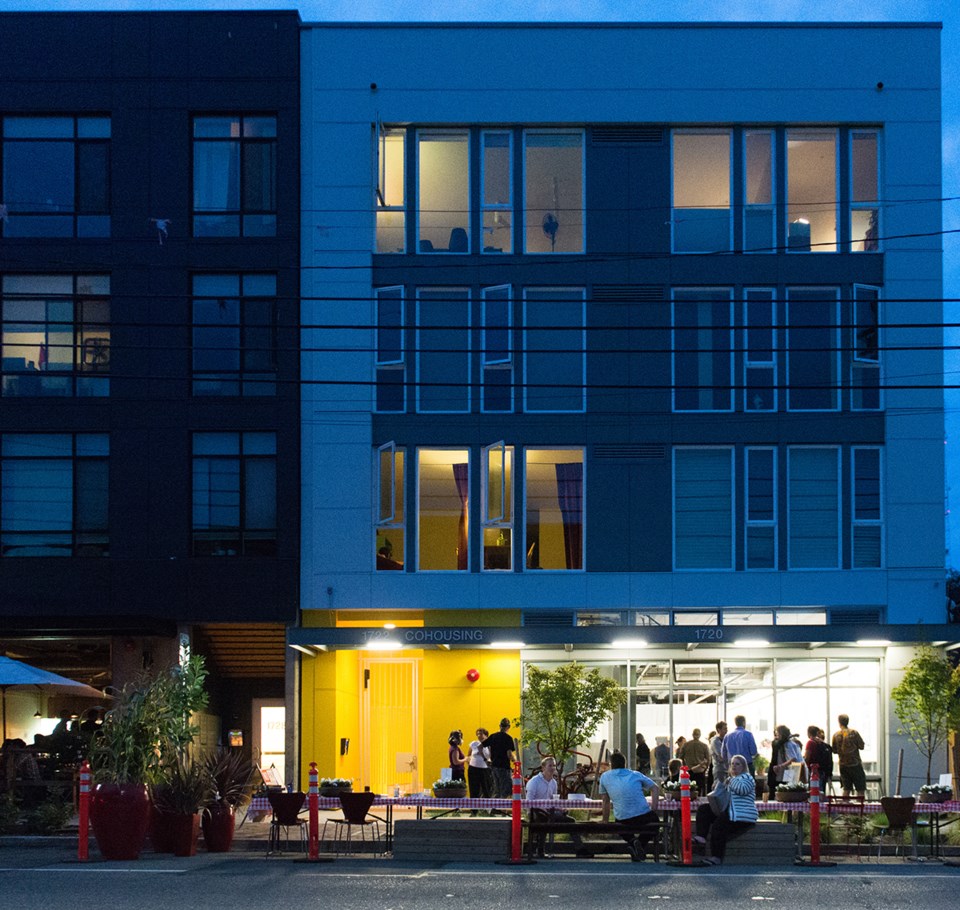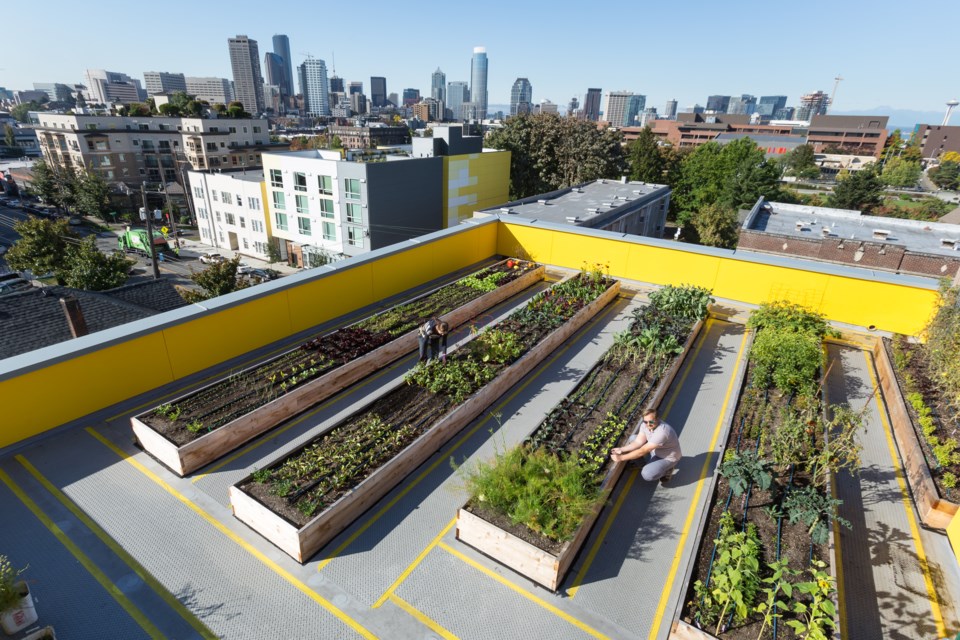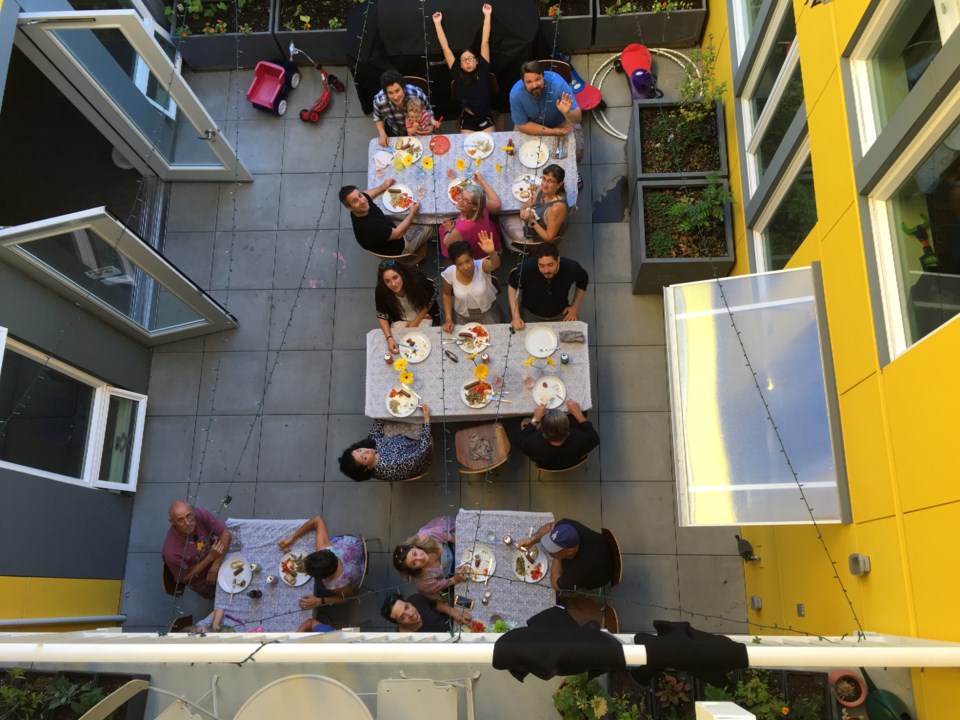Grace Kim, an architect and founding member of Capitol Hill Urban Cohousing in Seattle, Wash., is the keynote speaker at this weekend’s sold-out cohousing conference in Vancouver.
It’s the first such conference in Canada, according to organizers. About two thirds of those attending are already in cohousing communities, while the remaining third are people interested in knowing more.
Cohousing is a collaborative style of living where a group of people buy property and then design and build a complex in which individuals or families typically own their own units but share large common areas, organize group meals several times a week and have responsibilities around the building. Unit prices typically reflect market rates, but residents benefit from extra common space and other advantages of living in an intentional community. Some savings are also realized if the group acts as the developer for the project.
The first such complex opened in East Vancouver in 2016, while a second, in Riley Park, is expected to open in the summer of 2019. A third complex, whose organizers have adopted what they call a “cohousing lite” model, is in the rezoning process. They hope to build on a property at the corner of Main and Ontario Place.
Kim’s complex in Seattle opened in 2016. At a Ted2017 Conference in Vancouver, she presented a talk called, “How cohousing can make us happier (and live longer),” which addressed the idea of loneliness and how it can be the result of built environments.
The Courier talked to Kim about her complex in Seattle and her thoughts about the cohousing lifestyle.
You did a talk about cohousing where you suggested it could be an antidote to loneliness.
When I gave the talk, there was a lot of [information] being published about [loneliness]. I think it’s increased even more so in the last year. I talk about loneliness because I think there are a lot of people that are interested in cohousing who are interested in community — who are seeking community in various forms. A lot of it has to do with the growing isolation that people are experiencing around the globe.
You differentiate being alone and loneliness.
There’s a difference [with] being alone and being lonely… I think about the condo we lived in before we moved here. There were 170 units and one of the reasons we bought in the building is there were great community amenities. There was a roof-top deck and there was a party room. We lived on a floor where there were only seven units and we thought there’s a way to have a smaller community on our floor.
But all of those people who moved in had very different reasons for moving in… Throughout the summer, [my family] and maybe 10 or 12 households would use the roof-top deck. When we first moved in, we thought we’d have to run upstairs and stake out a space because we’re not going to get a table. It was never a problem because there were so few people interested in being in that space… It was interesting to me, even if you have these community amenities, there needs to be a willingness and an intention to want to be together. So we could be in our home and have all these amenties and people around, and still be lonely.
It wasn’t that I was feeling lonely but my husband and I are fairly social and we had been committed to living in this building. We thought it would be great to know our neighbours. Every now and again, we’d put a note under seven doors to say, “We’re having a brunch, come on over,” or “It’s the holidays. We’re having cocktails, come on over.” We would get the same one couple that would come over.
It’s not that we were lonely — we have friends, we have family — but for the people who were in our everyday lives, that we pass in hallway, instead or just saying, ‘Hi,’ it seemed worthwhile to acknowledge we were in the same situation.
From our standpoint, it was like OK [we have] other things going on, but I can see from other people’s standpoint, who aren’t from the area or who aren’t as extroverted, how you can slowly come into a space surrounded by people and be completely lonely.
In your Ted2017 Conference talk, you call the common house in cohousing the “secret sauce.” Explain that.
The common house is the physical space where the community can come together, where you know somebody is probably going to be, or, if you sit there long enough, somebody will come through. It’s where you plan activities. It’s the go-to place. In our common house, we have meals there three times a week. That’s where we do our all our birthday celebrations. If people have their own celebrations, they have them there. It’s a place where if people are having a birthday celebration, neighbours chip in. It’s a supportive and collegial environment. All of that energy that’s created there permeates through the rest of the building.

Cohousing residents usually buy their own units, but Capitol Hill Urban Cohousing is rental?
It is. It is a complicated ownership model. Essentially, we are a resident-owned LLC (limited liability company), so the legal structure is that we’re a corporation and we all have leases with that corporation. So, it’s technically a rental, but we are all resident owners of the building. It’s more of a limited equity model. Without getting into the weeds about that, it is a rental from a purely legal standpoint.
That’s not typical?
Typically, cohousing is an ownership model. We intentionally chose this model because we had this strong desire for economic diversity. We didn’t intend to be pioneers but we have been.
Interesting because it seems to me that cohousing is a style of housing geared towards people with some financial means, at least in Vancouver, because of the price of land and subsequent price of units. Is that also the case in Seattle and is there a way to make it more affordable?
That’s the big challenge. In general, with the cohousing model, it’s historically been for a middle-income or upper-middle income, fairly privileged population that has choices. On top of that, when you try to develop in an urban area like Vancouver or like Seattle, the land prices are really high. So, in any city, oftentimes the cohousing developments get pushed to the suburbs because that’s where land was more accessible pricewise. Even then, it wasn’t inexpensive.
One of the things we were trying to accomplish with our project, aside from wanting to live there, was to prove that this was a model that was affordable long-term.
We’re paying what is considered by the banks market-rate rents. Because it was an apartment building, we had to charge market-rate rents for us to get a mortgage that would cover the construction cost.
So, from that standpoint, it’s quite expensive to rent here — you could own something for cheaper, probably. But the idea is that, over the long-term, we have a rent stabilization self-initiated plan. It would mimic a mortgage, meaning your house payments would be a stable number for as long as you live here. The idea being that when a new family moves in they might pay what might be equivalent to market-rate rents but they wouldn’t have a big down payment. The member joining us, instead of having to have 10 or 20 per cent down for a $700,000 or $800,000 unit, they pay $30,000 as a membership fee.
From that standpoint, it wasn’t at the lower-income ranges but in terms of the moderate income ranges, we were able to get [there]. And, because of the apartment model that we had, we were also able to qualify for the city’s multi-family tax exception program, which basically gives us a property tax abatement in exchange for providing 20 per cent of our units, which is two, below market rate. Two of the units had to be between 60 and 80 per cent of median income. We have two families in those units and we probably had another one or two that could have qualified. It’s our way of trying to approach affordability.
What do residents pay right now, monthly?
The two lowest ones are, I think, $1,600 or $1,800. The market rates units are between $2,400 and $3,600. That is actually in the mid-range for the neighbourhood. Since we set the rents, which was probably three years ago, the market has exploded even more. We’re doing projects now in the neighbourhood, as architects, where the rent is $4,000 to $5,000 for a similarly sized unit.

I’ve interviewed several people about cohousing in Vancouver and there seems a desire — I don’t know if this is the right word — to recruit other people. People do seem somewhat evangelical about it. Why do you think that is?
I’m not sure why everybody else is. I would definitely put myself in the evangelizing camp. For some people, it’s a justification for the lifestyle choices that they’re making. Sometimes it’s pure enthusiasm.
When we first moved to Seattle, we didn’t own a car and we were pretty committed to that. Many times people had questions about why we didn’t have a car. When we would start to explain it, they would get into a very defensive mode. We would talk about not wanting to have car for environmental reasons, and for a variety of reasons that were not economic. For a lot people, they were like, “You’re wearing a fancy jacket, you must have the money to own a car.” [But] it’s not about the money. There was constantly a feeling of a need to defend my decision.
I have to imagine there’s a little bit of that — if they’ve been in the [cohousing] development stage for three or four years, their family or their friends may have been questioning them so they need to be in a more proactive, evangelizing mode. But I also think there’s probably a lot of growth for them personally and they’re excited about it so they want other people to know.
What’s the main message you hope to impart during your keynote speech at the Vancouver conference?
I’m going to lead in with the loneliness piece because I think it’s so present in the news right now, but what I want to leave with attendees is a sense of hopefulness and what they can look forward to. A lot of people coming to the conference are going to be in the forming stages of their community or about to move into their project that’s under construction. There’s always a feeling when you’re in that process, and at that early stage, that you feel like the end is the move-in date. It’s just the beginning. The end is actually the means to the goal. It’s actually the opposite — once you move in, that’s the start of a new life together, which sounds really campy and more evangelical but it’s the start of the process.
When you move in, that's when you get to really start over in the group process. I always talk about the cycle or the circle of group process, which is forming, storming, norming and performing. That is a constantly changing cycle. That's true for any relationship or any group. Every time you add a new member or somebody moves out or somebody gets married or children are brought into the family, you start that process over again because the dynamic has changed. For so many folks that are so eager to move in, they're thinking, Oh, when we get there, we're done. It's just to remind them that these are relationships. Much like a marriage or a relationship you might have with a friend, you have to work at it. It's about communication. It's about hard work. But it's really rewarding and meaningful at the end of the day.
Note: this interview has been edited for length.
@naoibh



